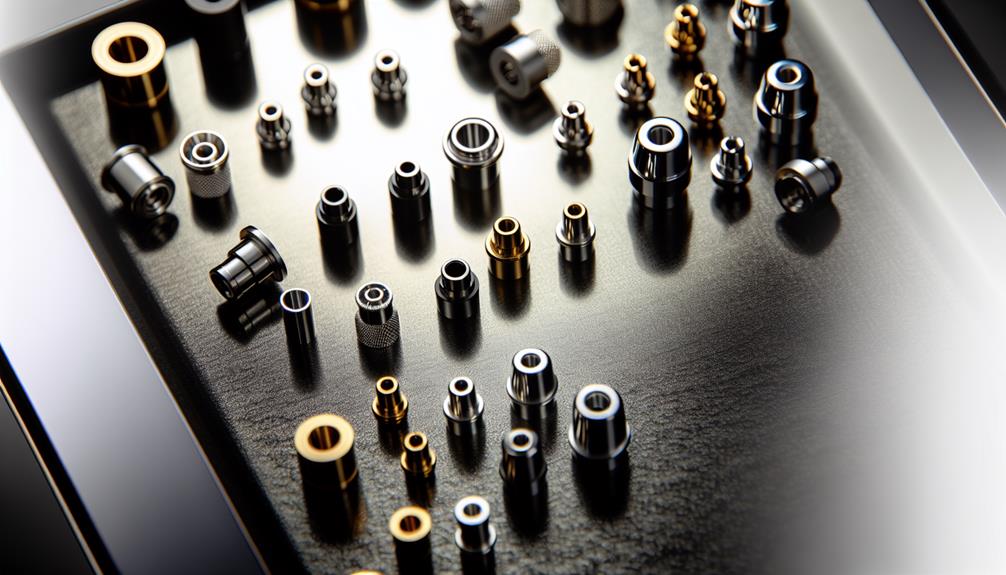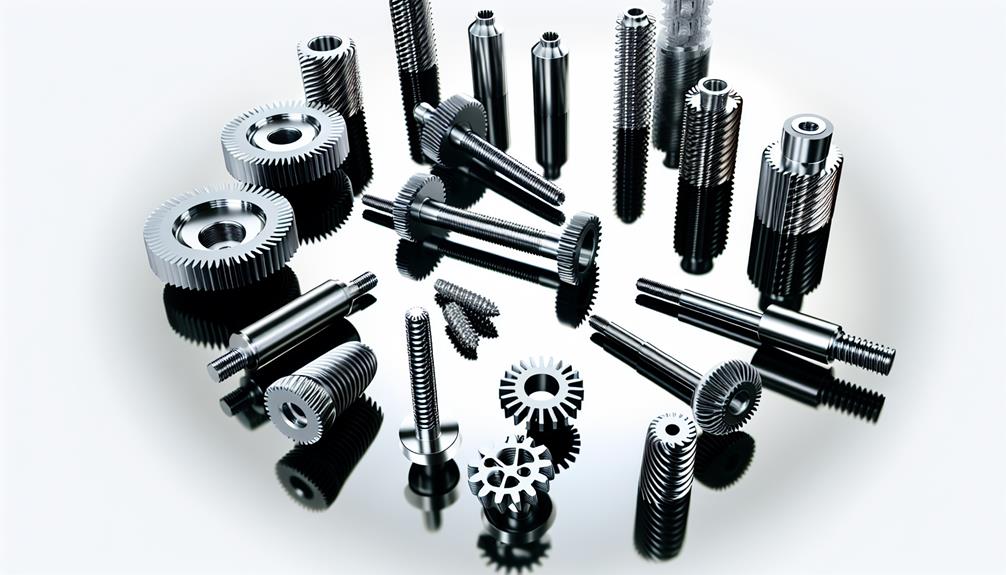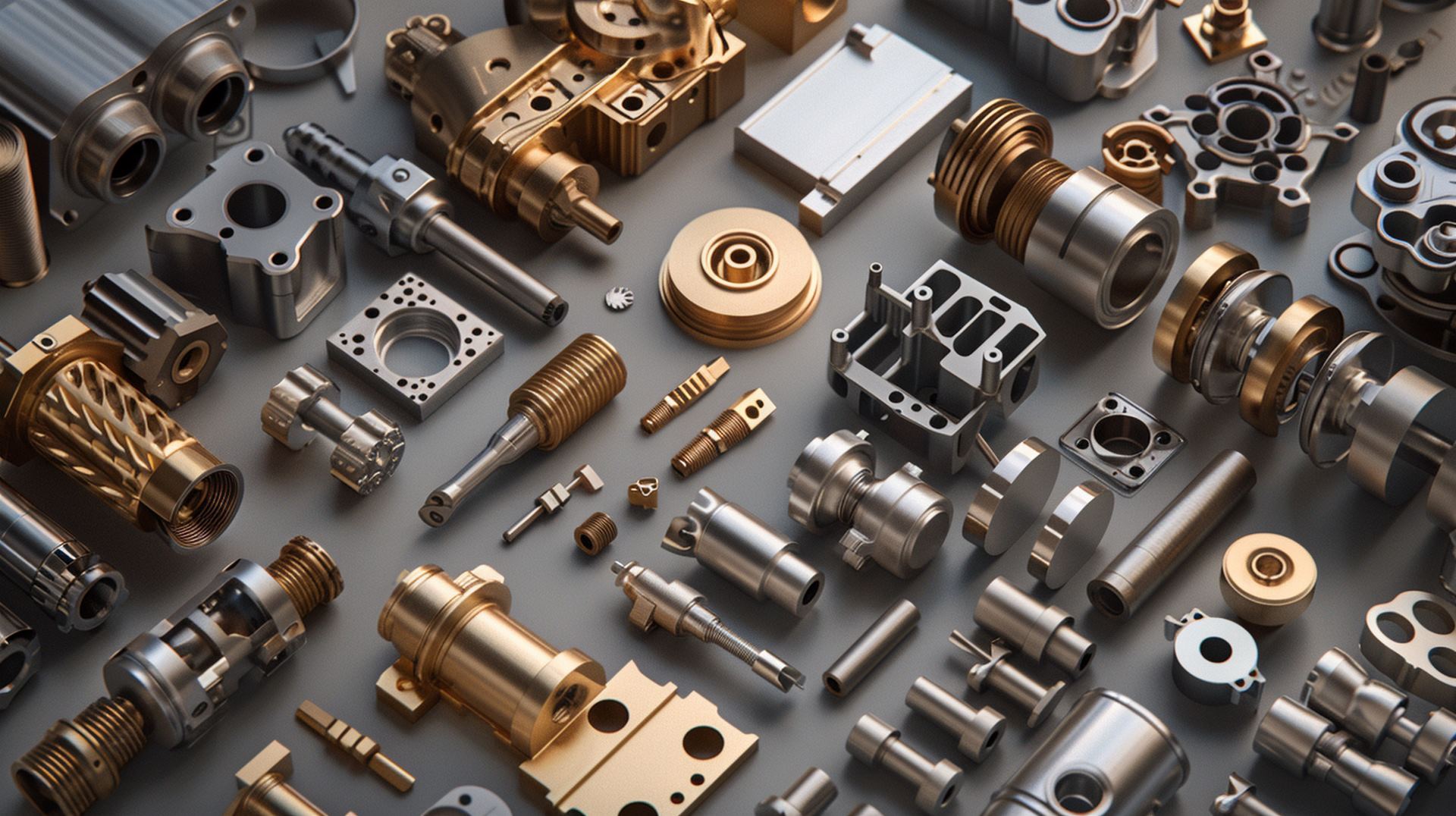Choosing the Best Metal CNC Machined Parts
In the realm of manufacturing, the choice of metal for CNC machined parts is pivotal, impacting not only the performance and durability of the components but also the efficiency of the production process itself. As we examine the assortment of metals available—each with its distinct properties and cost implications—it becomes clear that a strategic approach is essential for selecting the right material. Factors such as corrosion resistance, machinability, and thermal conductivity must be carefully balanced against the specific requirements of the intended application. The question then arises: how does one navigate these complex considerations to optimize product functionality and manufacturing productivity?
Key Takeaways
- Evaluate material properties like strength, corrosion resistance, and weight for your specific application needs.
- Consider precision requirements and ensure the CNC machine's capabilities match the complexity of the part designs.
- Assess the cost-effectiveness of different metals and machining processes to optimize budget and quality.
- Review post-processing options such as anodizing and heat treatments to enhance part performance and durability.
- Ensure the manufacturer adheres to stringent quality standards and offers thorough inspection processes.
1. What Are Cnc Machined Parts?

CNC machined parts are precision components crafted through a subtractive manufacturing process that involves removing material from a raw block using various cutting tools controlled by Computer Numerical Control (CNC) technology. This method allows for the production of custom designs tailored to specific requirements, enhancing functionality and performance. The flexibility in material selection is pivotal, as it enables manufacturers to choose the optimal material based on the application's mechanical demands, environmental conditions, and cost constraints.
Precision engineering is at the heart of CNC machining, ensuring components are produced with exact tolerances and fine details. This accuracy is critical for high-performance sectors where even minor deviations can lead to significant operational failures. Consequently, CNC machining integrates advanced quality control protocols to maintain consistency across batches, mitigating risks associated with defects and non-conformities.
Cost optimization is another significant advantage offered by CNC machining. By automating the production process, it reduces labor costs and minimizes waste, making it a cost-effective solution for both short-run and high-volume production.
The integration of these elements—custom designs, precise material selection, stringent quality control, and cost-efficiency—establishes CNC machined parts as essential components in modern manufacturing landscapes.
2. Applications of Metal CNC Machined Parts

Metal CNC machined parts are integral to various industrial applications, showcasing their versatility and precision. Key sectors that utilize these components include pneumatic and hydraulic systems, where accuracy and reliability are paramount.
Additionally, the automotive and aerospace industries heavily rely on CNC machined parts to meet rigorous safety and performance standards.
Pneumatic Parts
Precision-engineered pneumatic parts are crucial applications of metal CNC machining, providing essential components for various industries. The meticulous design of pneumatic systems requires components that meet stringent specifications for performance and reliability. CNC machining offers the precision necessary to produce these components with the exactness their function demands.
The selection of materials for pneumatic components is critical. Metals used in CNC machining, such as aluminum and stainless steel, offer the durability and strength needed for the high-pressure environments in which these systems operate. The advancements in pneumatic technology further push the boundaries of what can be achieved with CNC machined parts, leading to innovations that enhance system efficiency and functionality.
The pneumatic industry is currently experiencing significant trends towards automation and energy efficiency, driven by advancements in CNC machining capabilities. These innovations facilitate the development of more complex and reliable pneumatic applications, proving essential in sectors like automotive, manufacturing, and robotics.
| Keyword | Application in Pneumatic Parts |
|---|---|
| Pneumatic systems, design | Tailored for automated production lines |
| Pneumatic components, materials | Primarily metals like aluminum and stainless steel |
| Pneumatic industry, trends | Moving towards automation and sustainable practices |
| Pneumatic technology, advancements | Integration of IoT and real-time data monitoring |
| Pneumatic applications, innovations | Development of ultra-precise actuators and valves |
Understanding these elements is crucial for professionals seeking control over the performance and integration of pneumatic parts in their operations.
Hydraulic Parts
Hydraulic systems' reliance on CNC machined parts is pivotal for ensuring their robust performance and durability in demanding applications. Material selection plays a crucial role in this context, as the proper choice of metal can significantly influence the longevity and reliability of hydraulic components. Metals typically used in these systems, such as stainless steel and aluminum, are selected for their strength and corrosion resistance, which are essential for high-pressure environments.
Quality control is another critical factor. Each part must meet stringent standards to ensure that hydraulic systems function flawlessly. Precision in manufacturing avoids the risk of leaks or failures, which could lead to costly downtime or safety hazards. Consequently, rigorous performance testing is integral to the production process. These tests simulate various operational stresses to guarantee that each component can withstand real-world conditions.
Furthermore, design optimization contributes to the efficiency and cost-effectiveness of hydraulic systems. By refining component designs, manufacturers can reduce waste and improve the overall performance of the system. Cost analysis also plays a significant role, ensuring that the production of CNC machined parts remains economically viable while achieving the desired quality and functionality.
Through meticulous planning and execution, CNC machining helps craft hydraulic parts that excel in both performance and durability.
Automotive Parts
In the automotive industry, CNC machined parts are essential for manufacturing components that require high precision and reliability. These parts, crafted through precision engineering, are integral to producing custom designs that meet specific performance and aesthetic demands of modern vehicles.
The meticulous accuracy ensured by CNC machining allows for enhancements in vehicle performance upgrades such as engine components, suspension systems, and transmission parts.
The adaptability of CNC machining processes also ensures that various materials can be utilized, maintaining strict material compatibility. This is critical when selecting the appropriate metal that not only matches the performance criteria but also adheres to durability standards necessary for automotive parts subjected to high stress and variable environments.
Moreover, the capability of CNC machines to fabricate complex geometries ensures that newly designed components can be integrated seamlessly with existing automotive systems. This integration is crucial for aftermarket modifications and upgrades, enhancing both the utility and value of vehicles.
As automotive manufacturers continually push the limits of what is mechanically possible, CNC machined parts stand as pivotal elements in the evolution of automotive design and functionality, ensuring that both safety and performance standards are not only met but exceeded.
Aerospace Parts
CNC machined parts are crucial in the aerospace industry for manufacturing components that demand exceptional precision and durability. The manufacturing processes in this sector leverage advanced CNC technology to ensure each part meets stringent specifications crucial for safety and functionality. Precision engineering and meticulous material selection are at the core of this industry, facilitating the creation of components that can withstand extreme conditions without faltering.
Quality control measures and performance testing are rigorously applied, ensuring that every CNC machined part performs reliably under the stresses of aerospace operations. These steps are essential to maintain the integrity of aircraft systems, which directly influences the safety and efficacy of air travel.
Design optimization is another critical element, aimed at improving the aerodynamics and structural efficiency of components while maintaining cost efficiency. This balance is vital in an industry where both performance and budgetary constraints are constantly at play.
Customization options in CNC machining allow for the production of bespoke components that fit specific aerospace applications, thus reducing lead times and enhancing the overall efficiency of manufacturing cycles. This capability to tailor parts precisely according to aerospace engineering requirements not only optimizes production but also streamlines the supply chain, ensuring timely delivery of essential components.
3. The Advantages of Machined Parts
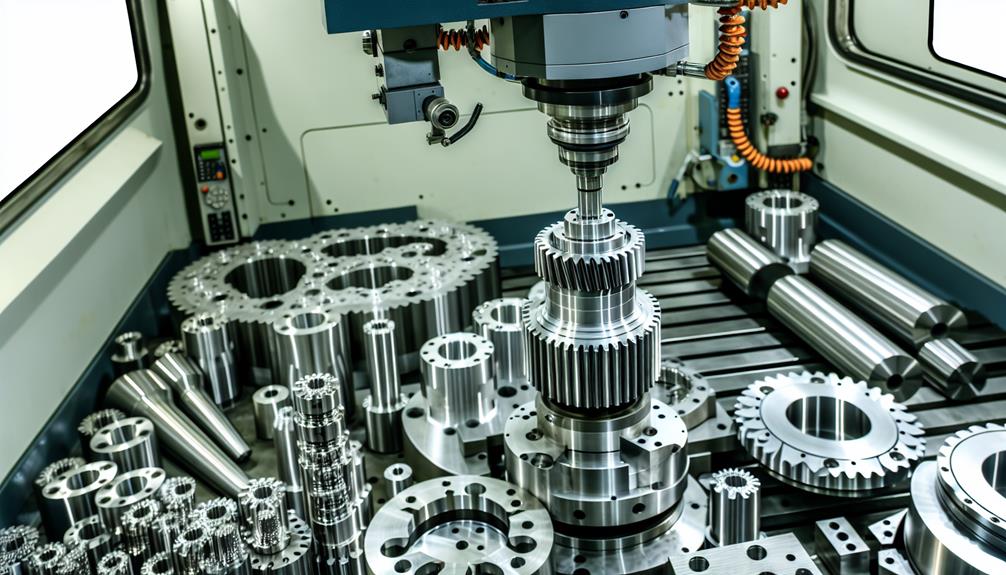
Metal CNC machined parts offer unparalleled precision and consistency in manufacturing, essential for complex and critical components. This level of precision engineering ensures that each part meets rigorous standards, which is pivotal in applications where precision is critical.
The high-quality surface finishes achievable through CNC machining not only enhance the aesthetic appeal but also contribute significantly to the functionality of parts, providing smoother interfaces that are crucial in many mechanical systems.
Furthermore, the versatility of CNC machining allows for cost efficiency. Unlike other manufacturing processes that may require new molds or setups for each variant, CNC machines can switch between jobs with minimal downtime. This adaptability makes it economically feasible to produce both small batches and large volumes, catering effectively to custom designs without significant additional costs.
Durability factors also play a critical role. Machined parts are typically stronger and last longer because the manufacturing process does not alter the internal structure of the material as much as other fabrication methods might.
This aspect is particularly important in industries where part longevity and reliability are paramount. By choosing CNC machined parts, companies gain control over the quality and lifecycle of their products, ensuring optimal performance and reduced need for replacements.
4. Metal Materials Used for Machined Parts
The selection of metal materials for CNC machined parts is critical for ensuring the desired performance and durability of these components. Commonly used metals include aluminum, tool steel, alloy steel, stainless steel, and titanium, each offering unique properties that cater to specific engineering requirements.
Understanding the characteristics of these materials helps in choosing the most suitable one for a given application.
Aluminum
Aluminum stands out as a preferred material for machined parts due to its lightweight, durability, and functional properties. Its inherent characteristics, including being light, durable, and corrosion-resistant, make it an ideal choice for industries demanding precision and longevity.
The ductility of aluminum allows for efficient machining techniques, enabling the creation of complex geometries and intricate details with high levels of accuracy.
Further enhancing its utility, aluminum can undergo various surface finishes, such as micro-blasting, polishing, and coating, which not only improve its aesthetic appeal but also increase its resistance to environmental factors. These finishing processes add a layer of protection, bolstering aluminum's natural corrosion resistance and extending the lifespan of the parts.
Weight optimization is another critical aspect when working with aluminum. Its non-ferrous and non-magnetic nature is beneficial in applications requiring minimal magnetic interference and lightweight structures, such as in automotive and aircraft components.
Tool Steel
While aluminum offers notable advantages for lightweight applications, tool steel is distinguished by its superior hardness and abrasion resistance, making it ideal for more demanding industrial environments. Tool steel excels in both durability and functionality, especially after undergoing specific heat treatment processes which enhance its mechanical properties. These treatments, tailored to the requirements of each application, significantly increase the steel's wear resistance, a critical factor in high-performance settings like aerospace and motor racing.
Moreover, the application of advanced surface coatings to tool steel parts further elevates their operational lifespan and efficiency. These coatings are engineered to resist environmental and mechanical wear, thereby preserving the integrity and performance of the machined parts under extreme conditions. The versatility of tool steel extends to various machining techniques, which are adeptly applied based on the complexity and precision required by the part's design.
Notably, the tool geometry is paramount in maximizing the effectiveness of these parts. Precise tool geometry ensures optimal cutting angles and surface contact, reducing wear and tear while improving the overall machining process. This geometric precision, combined with the material's inherent qualities, makes tool steel an indispensable choice for robust, high-quality CNC machined parts.
Alloy Steel
Alloy steel, known for its toughness and high fatigue strength, serves as a versatile material for CNC machined parts across various industries. Its exceptional ductility and abrasion resistance make it ideal for a wide range of applications, from functional prototypes to critical automotive and aerospace components.
Alloy steel's adaptability is further enhanced through heat treatment, which fine-tunes its mechanical properties to meet specific operational demands. Additionally, surface coatings can be applied to alloy steel parts to enhance their corrosion resistance and prolong their service life.
To truly appreciate the capabilities of alloy steel in CNC machining, consider the following advantages:
- Superior Impact Resistance: Alloy steel withstands severe impact and mechanical stress, ensuring reliability in demanding environments.
- Enhanced Fatigue Properties: The material's inherent strength prevents deterioration under cyclical loads, essential for automotive and aerospace applications.
- Customizable via Heat Treatment: Tailoring the hardness and strength to precise requirements is straightforward, providing control over the component's performance.
- Longevity with Surface Coatings: Options like chrome or zinc plating protect against corrosion and wear, extending the lifespan of machined parts.
These attributes make alloy steel a formidable choice for those who demand robust, enduring, and precise components in their operations.
Stainless Steel
Stainless steel, renowned for its corrosion resistance and mechanical strength, is a preferred material for CNC machined parts in various demanding applications. Its unique properties not only offer high durability but also provide extensive customization options which are crucial for industries requiring precise specifications and quality. The machining techniques of stainless steel include turning, milling, and laser cutting, which allow for the creation of complex geometries and high-quality surface finishes.
These surface finishes can range from matte to mirror-like polishes, enhancing the aesthetic appeal while increasing the resistance to environmental factors and reducing the adherence of bacteria and other contaminants. This makes stainless steel particularly valuable in medical, culinary, and aerospace applications where such traits are paramount.
| Feature | Benefit |
|---|---|
| Corrosion Resistance | Ensures longevity in harsh environments |
| Customization Options | Facilitates unique designs and features |
| Advanced Surface Finish | Improves appearance and functional utility |
Titanium
Titanium, distinguished by its exceptional strength-to-weight ratio and biocompatibility, is extensively used for CNC machined parts across various high-performance industries. Known for its robust titanium properties, this metal meets the rigorous demands of sectors requiring ultimate precision and reliability.
Consider the following aspects that underline the significance of titanium in critical applications:
- Superior Performance: Titanium's high strength and lightweight nature make it indispensable in aerospace applications. Its ability to withstand extreme environmental conditions ensures optimal performance of aerospace components from structural to engine parts.
- Advanced Medical Applications: The biocompatibility of titanium allows for its widespread use in medical implants. These components are not only strong and durable but also compatible with human tissues, preventing adverse reactions and promoting better recovery.
- Precision Machining Techniques: Employing sophisticated titanium machining techniques, manufacturers can achieve intricate details and complex geometries essential for customized and functional prototypes.
- Enhanced Durability: Through meticulous titanium surface finishing processes, such as micro shot-peening and polishing, the longevity and wear resistance of parts are significantly enhanced, ensuring they withstand rigorous use and extend their lifecycle.
Titanium's unique qualities and versatile processing capabilities render it an unparalleled choice in demanding sectors.
Brass
While titanium is favored for its strength and biocompatibility, brass is equally valued for its excellent machinability and resistance to corrosion and wear in the manufacture of functional prototypes and production parts. Brass properties make it an ideal choice for a variety of applications, allowing for the creation of both standard and complex components with ease.
The inherent machinability of brass significantly reduces tool wear compared to other metals, which facilitates cost-effective production cycles. This advantage in machining techniques not only optimizes manufacturing time but also minimizes the need for frequent tool replacement, thus enhancing overall efficiency.
Advanced CNC machining tools can execute precise cuts that adhere strictly to specified tolerances, resulting in parts with superior dimensional stability and aesthetic surface finishes.
When it comes to material selection, brass stands out due to its balanced attributes of durability and workability. It is particularly beneficial for industries requiring parts that must withstand environmental stress without compromising structural integrity. Additionally, cost considerations are favorable when using brass, as its ease of machining and lower raw material cost contribute to a more economical production process compared to metals that are harder to machine.
This makes brass a compelling option for budget-conscious projects demanding high precision and reliability.
copper
Copper is highly regarded in CNC machining for its non-magnetic properties and exceptional corrosion resistance and conductivity. Its unique copper properties make it a favored choice for a variety of applications, including the direct manufacture of functional prototypes, production parts, customized parts, and spare. However, certain machining challenges such as material malleability and tool wear must be managed to exploit its benefits fully.
To truly appreciate the value of copper in CNC machining, consider the following points:
- Material Compatibility: Copper's excellent thermal and electrical conductivity make it indispensable in electrical components, heat sinks, and other applications where energy efficiency is crucial.
- Surface Finishes: Achieving precise and aesthetically pleasing surface finishes with copper demands expert handling and appropriate tooling, reflecting a blend of art and precision engineering.
- Machining Challenges: While copper's ductility allows for creating complex shapes and fine details, it also requires careful handling to avoid deformations and extend tool life.
- Cost Considerations: Although copper is generally more expensive than some other metals, its durability and efficiency can lead to lower overall lifecycle costs in many applications.
Selecting copper for your CNC machined parts involves balancing these factors to harness its full potential while managing costs and ensuring product quality.
Find the Right Metal CNC Machining Materials for Your Product or Part
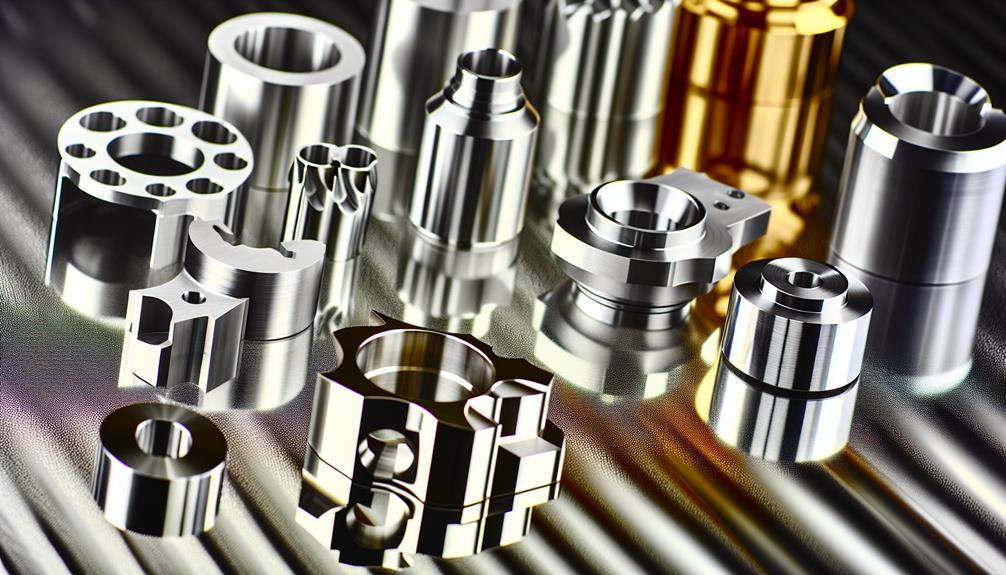
Selecting the appropriate metal for CNC machining is crucial and depends on specific factors including the intended application's environment, the required strength of the finished parts, and the machining time available.
Each material offers distinct advantages and limitations that can significantly impact performance and durability.
Moreover, considerations for finishes and post-processing should align with the functional and aesthetic requirements of the final product.
CNC Machining Time
The choice of metal significantly impacts the CNC machining time required for producing metal parts. Selecting a suitable metal not only influences machining efficiency but also has profound cost implications. Material selection, therefore, becomes a pivotal decision in the manufacturing process.
By choosing metals that are easier to machine, such as aluminum, you can significantly optimize production times and enhance overall quality control.
Here are four key points to consider that can help streamline your decision-making process:
- Machining Efficiency: Opt for metals with higher machinability ratings to reduce CNC machining time and enhance throughput.
- Cost Implications: Understand that longer machining times translate to higher costs. Selecting the right metal can help manage and reduce these expenses.
- Quality Control: Metals that are consistent and easier to machine typically result in higher precision parts, ensuring stringent quality standards are met.
- Production Optimization: Efficient material selection leads to smoother production flows, minimizing delays and maximizing output.
Strength and Environment Requirements for the CNC Machined Parts
When selecting metals for CNC machined parts, considering both the strength requirements and the operating environment is crucial to ensure optimal performance and durability. Metals like steel alloys, known for their high strength, are preferred for parts subjected to heavy stress and loading.
However, when weight restrictions are critical, as in aerospace applications, titanium offers a strength comparable to steel but at a significantly reduced weight, enhancing fuel efficiency and payload capabilities.
The operating environment also dictates the choice of metal, particularly concerning corrosion resistance and temperature stability. For marine applications or chemical exposure, stainless steel or aluminum, known for their excellent corrosion resistance, are ideal choices. These materials ensure that the part maintains its integrity and functionality over time, even in harsh conditions.
Further, the anticipated impact durability and surface finish of the part should align with its functional requirements. Metals capable of withstanding high impacts without deforming are crucial in construction and automotive industries.
Similarly, a superior surface finish not only enhances appearance but can also contribute to the longevity and performance of the part by reducing wear and tear.
Finishes and Post-Processing for CNC Machined Metals
Understanding the relationship between the chosen metal and its required finishes and post-processing techniques is essential for optimizing both the functionality and aesthetics of CNC machined parts. The metal selection greatly influences the required surface finishes and post-processing methods, which then impact the final product's quality and cost.
When selecting a metal, consider these factors:
- Surface Finishes: Different metals achieve varying levels of smoothness and texture. The choice of metal can either facilitate or complicate the attainment of your desired finish.
- Post-Processing Techniques: Metals like aluminum might require anodizing to enhance corrosion resistance and aesthetic appeal, whereas steels might need heat treatments to improve mechanical properties.
- Cost Considerations: More complex post-processing steps can significantly increase overall costs. Choose a metal that balances between minimal post-processing needs and meeting quality standards.
- Quality Standards: Ensuring that the metal and its finishing comply with industry standards is crucial for applications where durability and performance are critical.
Frequently Asked Questions
How Do I Maintain CNC Machined Metal Parts?
To maintain CNC machined metal parts, implement preventative maintenance, utilize effective cleaning methods, apply lubrication techniques regularly, ensure surface protection, and adhere to strict inspection protocols to control wear and extend component lifespan.
What Are Typical Lead Times for CNC Machining Projects?
Typical lead times for CNC machining projects range from 2 to 6 weeks, influenced by material selection, surface finishing, cost analysis, quality control, and production efficiency, ensuring optimal project control and execution.
Can CNC Machining Accommodate Complex Part Geometries?
Yes, CNC machining excels in creating complex designs with high precision, offering custom solutions that ensure material compatibility and design flexibility. It provides extensive control over the final outcome of intricate geometries.
How Does CNC Machining Impact Environmental Sustainability?
CNC machining enhances environmental sustainability by improving energy efficiency, reducing material waste, and integrating green technologies. These sustainable practices help minimize the carbon footprint, aligning with the desires of control-oriented audiences for responsible manufacturing.
What Are the Common Certification Standards for CNC Parts?
Common certification standards for CNC parts ensure quality assurance, material compatibility, and production efficiency. These requirements address cost considerations while adhering to industry norms, enhancing reliability and compliance in manufacturing processes.
Mikehardware-your trusted custom metal cnc machined parts manufacturer
In conclusion, selecting the most suitable metal for CNC machined parts is paramount to achieving optimal performance and durability in various applications. By understanding the distinct properties of materials such as aluminum, stainless steel, and titanium, manufacturers can effectively tailor their choices to specific requirements.
How can one overlook the importance of such decision-making when it directly influences the success of technological innovations? Thus, a strategic approach to material selection is essential for advancing industry standards and enhancing product functionality.
At Dongguan Mike Hardware Co., Ltd., precision engineering meets innovation, delivering impeccable CNC product manufacturing solutions. Explore our array of customized fasteners, screws, and coatings, ensuring your projects excel in performance, precision, and quality.
Contact us for a free quote of your ideal metal cnc machined parts.

